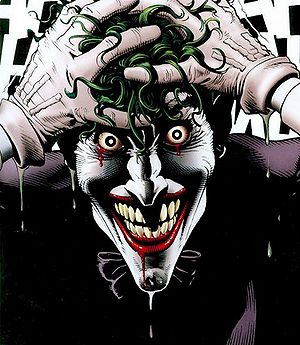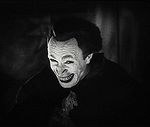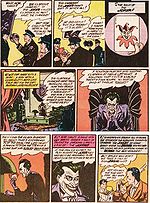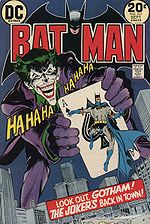Joker (Comics)
 From Conservapedia
From Conservapedia The Joker is a comic book villain created as Batman's nemesis for the spring 1940 issue of Batman #1 by DC Comics, and was the creation of Bill Finger, Bob Kane, and Frank Robinson. As the personification of destruction and chaos, the Joker has become one of the best-known villains in comics, novels, and film. Due to his infamous repertoire of crimes (many of which included mass-murder) simply for his own twisted amusement, as well as his clown-like appearance and demeanor, he was also sometimes known as the Clown Prince of Crime.
"Joker" is a critically acclaimed film which won a stunning first place at the Venice Film Festival in 2019, starring Joaquin Phoenix. This film does not portray Batman, and depicts the Joker as a disturbed anarchist causing mayhem in Gotham in 1981. An earlier portrayal by actor Heath Ledger in The Dark Knight earned for him critical praise and an Academy Award for Best Supporting Actor.
Contents
History[edit]
Kane, Finger, and Robinson are credited with the creation of the Joker, but what exactly transpired is a bit of a mystery. Robinson, according to some sources, produced a playing card bearing the image of a joker and suggested that it was DC's next villain. Kane, the creator of Batman, insisted that it was himself who had done so, basing his interpretation on a character named Gwynplaine from a 1928 silent film titled The Man Who Laughs.[1] The image of an unearthly, knife-carved grin - as portrayed by German actor Conrad Veidt - stuck with Kane, and were reflected in the panels of the Joker drawn for Batman #1.[2]
The Joker was portrayed as a psychopathic murderer who left an unusual calling card: The bodies of his victims with their faces contorted in a grotesque smile, but his actual origins were not established until much later. In 1951 Detective Comics #168 presented "The Man Behind the Red Hood", which placed Batman against a criminal who struck once more after a ten-year hiatus. The revealing of the Red Hood to be the Joker also revealed his origins: Once a lab worker, he was going to retire off of a million dollars stolen from a nearby playing card company, but his escape with the loot through chemical wastes had altered his appearance, bleaching his skin white and turning his hair green.
In the mid-1950s public backlash against comics in the wake of Dr. Frederic Wertham's book Seduction of the Innocent: The Influence of Comic Books on Today's Youth forced many comic publishers to either change their format or go out of business; indeed, much of what was published - either in mainstream comics or so-called "underground" versions - was dark, violent, and sometimes gory. The Joker went through a change as a result: The insane, homicidal character was reduced to a campy prankster who used a lot of jokes and puzzles in his crazy, yet seemingly harmless, crimes. The additions of a "Joker-mobile" or a Batman-like utility belt didn't help his stories, either, and when Julius Schwartz - who hated the Joker - took over the Batman editorial position, the Clown Prince of Crime was relegated to the trash can.
1960s & 1970s[edit]
But the Joker wouldn't die so quickly, as producer William Dozier placed the Joker in the fifth episode of his 1966-68 television series Batman.[3] Played by veteran actor Cesar Romero,[4][5] this new film version kept in line with the campyness and wackiness of the comic character, though it would exclude his mass-murdering persona (the only attempted victims would be Batman and Robin). One of the big-name stars who was attracted to film guest appearances in the series (along with Burgess Meredith, Julie Newmar, Frank Gorshin and Vincent Price, among others), Romero had an unusual trait which he insisted not be touched: A well-groomed mustache, which was hidden under his white makeup.
With Batman still in prime time as a live-action series for ABC in 1968, the animation company Filmation Associates brought to CBS Saturday mornings The Batman/Superman Hour, a cartoon series featuring the main DC superheroes in various seven-minute shorts; Joker appeared in several and was voiced by veteran comic actor Larry Storch. This very-tame version of the Joker was carried over to an episode of Hanna-Barbera's New Scooby Doo Movies in 1972, where he and fellow villain Penguin run a counterfeiting ring while enjoying their new stolen "ride": the Batmobile.[6]
1970s remake[edit]
In 1973 DC did an extensive revamping of the Batman series and characters, returning to their earlier roots of dark and compelling stories. Brought out of the trash can, the Joker committed his homicides once again according to the writer-artist team of Denny O’Neil and Neal Adams in the pages of Batman #251 (Sept. 1973), in an instant classic titled "The Joker's Five-Way Revenge." Escaping from the "state hospital for the criminally insane" - the first instance of what would be called Arkham Asylum - the Joker hunts down his former henchmen in an effort to get revenge on the man who put him there for twenty years, with the added pleasure of taunting both the police and Batman to stop him in a dark format that O'Neal and Adams have deliberately made to be as close as possible to film noir.
In the story "The Laughing Fish," (Detective Comics #475, March 1978), writer Steve Englehart and artist Marshall Rogers defined the Joker's psychosis further, in which the Joker had applied for a patent for a chemical which causes a wicked grin in fish, of which he would be able to collect royalties for his "invention," with the added joke that he would kill anyone who pointed out just how crazy his invention was. Although a two-part story with no more than three murders, "The Laughing Fish" left an impression on readers: the Joker's madness had risen to new levels, and the stories were getting more compelling.
1980s[edit]
In the 1980s Frank Miller was an artist/writer for Marvel Comics; he had revamped the character of Wolverine and placed a film noir look in Daredevil - creating a love interest with Electra along the way - to critical acclaim. When he moved to DC he had the beginnings of a story that would set the comics industry on fire, and the Joker was part of it. In Batman: The Dark Knight Returns [7] the Joker had spent ten years of a dystopian future locked away an Arkham as a dormant shell of a man, while the Batman had made a similar disappearance. The news of Batman's return to fight crime once more has the Joker convincing his doctors that he has been rehabilitated; his release into the public allows him a killing spree like Gotham had never seen before.
At the same time as The Dark Knight Returns, another influential tale hit the stands: Batman: The Killing Joke (1986).[8] Essentially a graphic novel, writer Alan Moore elaborated on the Joker's origin from the earlier "Red Hood" story by making him more of a tragic character, changing him to a stand-up comedian who turns to crime after he fails on the stage in a desperate attempt to provide for his wife and unborn child, and becoming a victim of a chemical bath when a factory break-in goes wrong, partially because Batman arrived on the scene. The central point of The Killing Joke was the Joker's attempt to prove to Batman that given the right conditions anyone can go insane, and he nearly proves it by the kidnapping of Commissioner Gordon and the paralyzing of the Commissioner's daughter, Barbara, as well as undressing her and photographing her while she was nude and in agony. The story also reveals his more nihilistic outlook on life, where he explicitly considers everything people struggle for as being "a monstrous, demented gag", as well as implying that the start of World War II was due to an argument with Germany regarding how many telegraph poles they owed their war debt collectors, with the flashbacks heavily implying that his nihilism and even his more horrific nature ultimately stemmed from going insane after having a very terrible day.
As The Killing Joke was gaining critical reviews, A Death in the Family was released as a normal four-part comic.[9] According to the story, Jason Todd - Batman's sidekick Robin - had embarked on a search for his mother, an aid worker in Ethiopia then being embezzled by the Joker; as the story continued, the Joker would take Robin hostage as well, beating Robin nearly to death while at the same time taunting Batman. This story had the added twist of fan participation to determine if Robin lived or died, via a pair of toll-free numbers to DC.
1990s[edit]
With the success of Tim Burton's 1989 film Batman (see below), an animated series was pitched. With the release of Batman: The Animated Series on Fox Kids in 1992, the Joker (whose appearance and personality in this series was based largely on Jack Nicholson's portrayal of the character in the 1989 movie) was an essential part of the series. In the animated Batman, Joker was also given a new female criminal accomplice, Harley Quinn, who soon became established as a prominent villain (and in some interpretations, an anti-hero) in her own right in later DC Comics media. He would be voiced by Mark Hamill, known for playing Luke Skywalker in the Star Wars Trilogy. Hamill's voicing of the Joker would be the most iconic. He would continue to voice the Joker throughout the animated series, as well as the animated film Batman: Mask of the Phantasm (1993), and The New Batman Adventures (1997).
2000s[edit]
In the animated film Batman Beyond: Return of the Joker (2000), Mark Hamill would return to voice the character. Hamill would also provide the voice of the Joker for Batman: Arkham Asylum (2009). The 2000s also saw the release of The Dark Knight (2008), where the Joker was played by Heath Ledger. Ledger died on January 22, 2008, several months prior to the release of the film. He would go on to posthumously win an Oscar for Best Supporting Actor at the 81st Academy Awards.
2010s[edit]
In 2010, Joker appeared in the animated film Batman: Under the Red Hood as the secondary antagonist, based on the Under the Hood story arc. He was voiced in this instance by John DiMaggio. Mark Hamill returned to provide the voice of the Joker once again in Batman: Arkham City (2011). In the two-part film adaptation of Batman: The Dark Knight Returns, Joker also appeared as a cameo in the first part, and as the primary antagonist for the first half of the second part, where he was voiced by Michael Emmerson in a manner similar to that of the comedian Paul Lynde. The character would also appear in Batman: Arkham Origins (2013), this time voiced by Troy Baker. Baker would later reprise the role as Joker in the companion game Batman: Arkham Origins Blackgate as well as the 2014 animated film Batman: Assault on Arkham. Hamill would reprise the role in Batman: Arkham Knight (2015). 2014 would see the release of the TV series, Gotham, which follows a young James Gordon, Bruce Wayne not long after the murder of his parents, and several Batman villains. A character named Jerome Valeska, played by Cameron Monaghan, shares many similar traits with the Joker with it being strongly implied that he would either eventually become the Joker, or otherwise inspire someone to become him, with the latter ultimately being confirmed when he managed to posthumously turn his twin brother Jeramiah Valeska into the Joker via laughing gas. In December 2014, Jared Leto was announced to be playing the Joker in Suicide Squad (2016). In addition, an animated adaptation of The Killing Joke was made, starring Mark Hamill as the Joker, Kevin Conroy as Batman, and Tara Strong as Batgirl. The Joker also played the main antagonist in The Lego Batman Movie, played by comedian Zach Galifianakis.
Film adaptions[edit]
Batman (1989)[edit]
In 1989 Tim Burton's Batman was released, with Jack Nicholson going all-out as the Joker[10] in a performance that many felt upstaged the title character. In this film the Joker's origins remain true with the Red Hood story but are slightly-modified; he is given a name - Jack Napier - and is portrayed as a mob enforcer who is double-crossed by his boss while attempting to fake a case of industrial espionage at a chemical factory as revenge for him having an affair with his wife. A police raid on the factory, as well as the arrival of Batman, ends with Napier falling into a chemical tank, creating the Joker. Burton's version also has Napier shown as a much-younger man (played by Hugo Blick) via a flashback scene: he was the one who committed the murder of Bruce Wayne's parents, the act which eventually created the Batman.
The Dark Knight (2008)[edit]
Tim Burton and Joel Schumacher's series of four movies eventually departed to the camp of the 1960s television series with the release of Batman and Robin in 1997, a critical and financial flop. This also caused the cancellation of the proposed fifth installment of the Burton/Schumacher films, titled Batman Triumphant. Rebooting the franchise led to the Christopher Nolan film Batman Begins in 2005; the success of which enabled a sequel which was released in 2008. Using the comic book stories The Long Halloween and The Killing Joke as inspirations, Nolan returned the Joker to the big screen in The Dark Knight.[11] Almost universally lauded by critics and shattering numerous box-office records, The Dark Knight featured the final performance of Heath Ledger as a monstrous version of the Joker,[12] a psychotic who thinks the only sane way to live is without rules and wants to prove it to the world - and at the same time giving the artists and writers who penned the Batman stories a version of the Joker they thought was closest to their own. "He's trying to police a villain the likes of which he's never seen," said actor Gary Oldman in a recent interview, describing just how evil he thought this film version of the Joker actually is. "He makes Voldemort (the villain of the Harry Potter series) look like a Sesame Street character".[13] The premise of the film, which begins in a hopeful manner with the arrests of mob figures and the reduction of crime, spirals downward as the remaining elements of the mob turn to the Joker, who turns out to be "a man they didn't fully understand",[14] and someone who is just as dangerous to the mob as he is to Gotham City.
The effect of Ledger's performance has caused some fans to ask Warner Bros. to cease placing the Joker in any future films.[15]
Suicide Squad (2016)[edit]
Jared Leto portrayed the Joker in the 2016 film, Suicide Squad. Leto's interpretation of the Joker in the film had the character strongly resembling controversial shock rock musician Marilyn Manson.[16] In addition, Leto when preparing himself for the role of the Joker had interacted with prison psychopaths to get a feel for the character and his sociopathy.
Joker (2019)[edit]
Joaquin Phoenix portrayed the Joker in the 2019 film of the same name, directed by Todd Philips. This version of the character sees him as a socially awkward man named Arthur Fleck, who, throughout the movie, begins to lose his sanity. The film earned Phoenix an Oscar for Best Actor.
Real crime incidents[edit]
Unfortunately, the Joker has inspired several people to take an obsession with the character to the next level, with sad or tragic results. The Dark Knight Rises was released in 2012, the concluding film to Christopher Nolen's Dark Knight Trilogy. On July 20, 2012 during a midnight showing of the film at a theater in Aurora, Colorado (which was itself technically a "gun-free zone"), a man named James Eagan Holmes[17] set off tear gas and shot into the audience, killing 12 people and injuring 70 others. Holmes, when arrested, claimed that his actions were inspired by that of the Joker, and that he even dressed in a manner consistent with the Joker's look.[18] The shooting, like many other events similar in nature, sparked gun control debate.
See also[edit]
References[edit]
- ↑ http://laughingsquid.com/the-original-inspiration-for-batmans-joker-german-actor-conrad-veidt/
- ↑ http://entertainment.howstuffworks.com/arts/comic-books/joker.htm
- ↑ https://www.imdb.com/title/tt0059968/
- ↑ https://www.imdb.com/name/nm0003110/
- ↑ https://www.youtube.com/watch?v=CjiIHfKwi0Q
- ↑ https://web.archive.org/web/20010330091127/www.cartoonnetwork.com/doc/newscoobydoo/fe.html
- ↑ http://www.dccomics.com/dcu/graphic_novels/?gn=1279
- ↑ http://www.dccomics.com/dcu/graphic_novels/?gn=1282
- ↑ http://www.dccomics.com/dcu/graphic_novels/?gn=1223
- ↑ https://www.youtube.com/watch?v=vWEhueUvVdM
- ↑ https://www.imdb.com/title/tt0468569/
- ↑ https://www.youtube.com/watch?v=ohU16OiduUs&feature=related
- ↑ https://www.youtube.com/watch?v=hoSCGb5fJRs&feature=related
- ↑ https://www.youtube.com/watch?v=UWw0ov-cAUg
- ↑ https://www.wired.com/underwire/2009/02/heath-ledger-nu/
- ↑ The Joker in Suicide Squad at the DC Database Wiki
- ↑ https://www.nytimes.com/2015/05/29/us/james-holmess-notebook-and-insanity-debate-at-aurora-shooting-trial.html
- ↑ https://www.breitbart.com/entertainment/2012/07/20/massacre-suspect-the-joker/
Categories: [Culture]
↧ Download as ZWI file | Last modified: 02/25/2023 18:47:13 | 3 views
☰ Source: https://www.conservapedia.com/Joker_(comics) | License: CC BY-SA 3.0
 ZWI signed:
ZWI signed:






 KSF
KSF